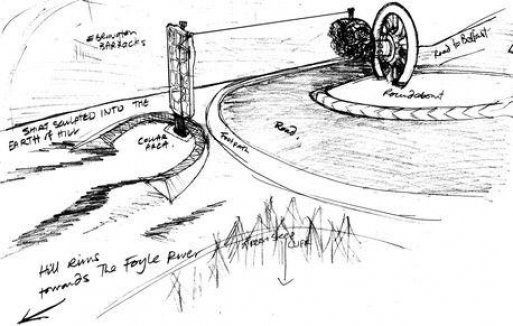Monument to Derry Women on Hold by City Council
Published: Wednesday, October 19, 2011

Louise Walsh, a Cork born artist, has dedicated six years of both her personal and professional life into a sculpture which she believed to be of historical and public significance in Derry. In 2006, Walsh was commissioned by the Department of Social Development to create a piece of public art to highlight the important role of generations of women who worked in the famous shirt factories, and the impact they had in shaping the history of Derry. Walsh's work is complete but lying in pieces around the city. Louise, and the women, who contributed to her project want to know why.
She had already established herself as a noteworthy and politically engaged artist by the time she involved in the commission in Derry, producing work which is beautiful while at the same time tackling both social justice and feminism. After completing her MA in the University of Ulster, she eagerly took up a commission to complete a sculpture for Belfast City Council, unaware of the barrage of trouble that was about to rain down on her.
A fervent support of feminism, Walsh intended to work this politics into her project, as the remit she was provided with left a lot to be desired. "The brief was awful," Louise recalls. "It was cartoony. It was to figuratively represent the social history of the area, described only in terms of prostitution." The piece was to be placed near Amelia Street, which used to be notorious for its brothels.
Louise felt the brief trivialised prostitution and ignored important industries in the area such as textiles. She felt it was only right to acknowledge the fact that the majority of women at the time either worked in the house, achieving neither financial nor social status, or they made up the majority of low-paid workers. She believed it was inherent to the spirit of the piece to incorporate both these aspects of Belfast's working society.
After a lot of chest-beating and political outcries, her work culminated in the now-famous "Unknown Woman Worker", an iconic and much admired statue currently sitting on the main thorough-fare of Belfast city, outside Victoria Street Station. . Accusations of portraying prostitution and indecency in the streets were bandied about.
"People couldn't look at it figuratively," explains Louise. "They thought of it as a monument to prostitution."
Nonetheless, the storm passed and Walsh found herself once more in the running for a commissioned piece of public art, this time based in Derry.
A site specific public art project celebrating the contribution of the textile workers, Louise believed this would be her dream job. Taking unpaid leave, she poured her artistic heart and soul into the work. She wanted to make a piece that reflected the magnitude of the contribution of the women workers to the city.
Aside from the project itself, Walsh spent weeks interviewing the women involved in the shirt factories. She compiled tapes and archives which she intended to accompany the launch of the piece. She wanted to chronicle the life and times - socially, politically and economically - of the city through the eyes of these women, who had played such an important role in the history of Derry. The piece, a sculpture of a sewing machine with a shirt laid out on the grassy slope leading down to the River Foyle, was to stand in a prominent position in the Waterside.
Two years into the job, things had started to look decidedly shady. Money was running out and there seemed to be an issue concerning planning permission, one which Louise had been assured would not affect her or her work. Disappointed but determined to continue, Louise tried to accommodate these concerns and re-designed her idea for another site. But nothing has happened.
MIM, the engineering firm that created the giant wheel at the core of Walsh's design, are at a loss as to what is holding up the design. It claims that, if given the go-ahead for completion, the sculpture could be in place within six months. MIM worked closely with Walsh during the process of making the sculpture when it was inexplicably put on hold.
MIM has been paid but its staff are aggrieved at what they see as a wasteful and unnecessary hold-up. Having worked with Walsh on her large-scale installation at the Royal Victoria Hospital in Belfast, they were no strangers to this process. It disheartens them greatly to think that this particular piece might never see the light of day. As natives of Derry City, it would have been a matter of great pride for them to see the work displayed at home.
To add insult in injury, all work was paid for from the public coffers making the whole incident seem unnecessary and careless.
In response to our inquiries, Derry City Council said that it fully intends to get the work up and a spokesperson said the council believes it is a significant piece of public art. They blame public realm issues for the delay, citing the assumed access to the Peace Bridge along with the refurbishment of the Guild Hall. Unfortunately, it seems to those involved in trying to get this exciting project off the ground, that this is a line that has been turned out many times before. Everyone involved is starting to get more than a little weary. Given the amount of work invested by the women of Derry, Walsh and MIM and given the importance of what the project represents, a resolution needs to be found and found fast. And that is before we even touch on the waste of much-needed public funding.
Much thanks and admiration for those who have supported Louise such as Darinagh Boyle, editor of Derry's Local Women magazine which has played a huge support in generating publicity for the sculpture. Also, Declan MaGonnigle, an art guru, who has thrown his weight wholeheartedly behind the campaign. The artists and artisans of Derry have also voiced their support and outrage at the situation. But most importantly of all, the women of Derry themselves.
Michelle Culbert
